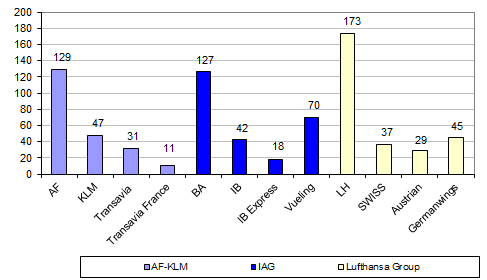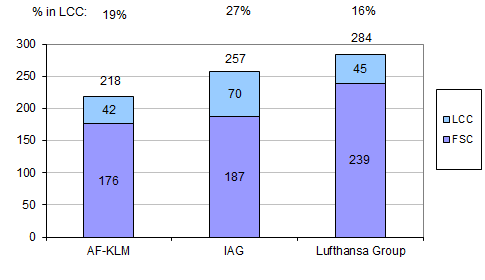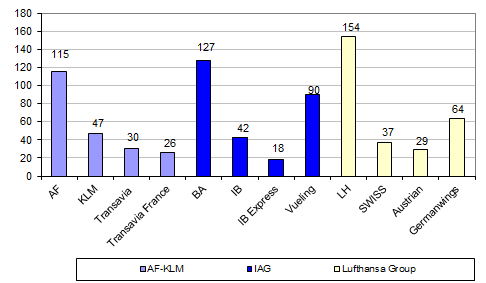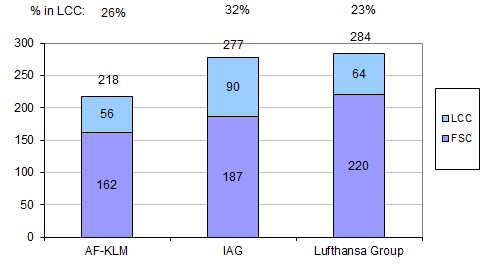Transavia France to add destinations, but Air France-KLM’s LCC vision remains relatively limited
In the summer of 2014, Transavia France is to add new destinations to its network from Paris Orly and also from other (regional) French airports. In addition, Transavia France will open a base at Strasbourg in Apr-2014. According to data gathered by CAPA, a total of 19 new routes from France, of which 10 are from Orly, will be launched this summer. Six of the Orly routes will utilise A320s leased from Air France.
However, this development does not represent a transfer of routes from Air France to Transavia (as, for example, Lufthansa is doing with its LCC Germanwings). This returns the spotlight on Air France-KLM's plans for Transavia and on the contrasting ways in which Europe's Big Three legacy groups are using their LCC subsidiaries in the short/medium-haul markets. With pan-European LCC Vueling and hub feeder Iberia Express in its stable, IAG would seem to have the most comprehensive approach of the three.
- Transavia France is adding new destinations to its network from Paris Orly and other French airports, and opening a base at Strasbourg in April 2014.
- The new routes focus on leisure markets and will have a frequency of only once or twice weekly, indicating they are not aimed at business travelers.
- Transavia France will lease six A320 aircraft from Air France to operate some of the new routes, increasing its fleet size and adding complexity in terms of crew rostering, training, and maintenance.
- Transavia France's fleet will grow to 26 aircraft by 2016, as part of Air France-KLM's plan to transfer more medium-haul aircraft to its LCC subsidiary.
- Air France-KLM's strategic vision for Transavia is more limited compared to Lufthansa's Germanwings and IAG's Vueling, focusing mainly on point-to-point leisure markets and reducing hub feed and regional point-to-point activities.
- Air France-KLM's LCC fleet will account for 12% of its narrowbody fleet by 2016, while IAG's Vueling will account for 32% and Lufthansa's Germanwings for 23%.
See related report: Lufthansa, Air France-KLM, IAG adopt short haul initiatives to combat LCCs: Airlines in transition
Transavia France's 19 new routes
The 19 new routes compare with a total of more than 100 routes for Transavia as a whole (both the Netherlands and France operations). Looking through the new Transavia France routes, only on Paris Orly-Pisa, which was previously operated by Air France, does it look like a straight transfer from it to Transavia. There are 11 routes that are not currently operated by any Air France-KLM Group company and seven routes where Air France will continue to operate alongside Transavia (treating routes as city pairs, not just airport pairs).
Out of the 19 new Transavia France routes, four are routes where no other carrier operates and so it will have a monopoly on these four routes. One of these four, Lyon-Madeira, is to be part of a triangular Lyon-Porto-Madeira service. Although there is not set to be any competition on Lyon-Madeira, easyJet competes on Lyon-Porto and TAP Portugal competes on Porto-Madeira.
On the 15 routes with competition, 11 have more than one competitor and 11 have LCC competition (seven with more than one LCC competitor). Of the seven routes that Air France will continue to operate alongside Transavia, six have LCC competitors.
The focus of the new routes is on leisure markets and more than half of them will have only a single or twice weekly service. Only one, Paris Orly-Rome Fiumicino (10 times weekly), will have a frequency of daily or more. This kind of schedule is clearly not aimed at business travellers on most of these routes.
Transavia France new routes for summer: 2014
|
Route |
Weekly freq |
Launch
|
Competitors on city pair (and airports
|
|---|---|---|---|
|
1x |
19-Apr-2014 |
||
|
1x |
26-Apr-2014 |
Aegean |
|
|
2x |
27-Apr-2014 |
Monopoly |
|
|
2x |
27-Apr-2014 |
||
|
1x |
26-Apr-2014 |
Jetairfly, Air Mediterranée |
|
|
2x |
26-Apr-2014 |
Aegean |
|
|
1x |
22-Apr-2014 |
Monopoly |
|
|
1x |
09-Jul-2014 |
Monopoly |
|
|
5x |
12-Apr-2014 |
easyJet, Aegean (CDG), Air France (CDG) |
|
|
Paris Orly-Barcelona |
6x |
25-Apr-2014 |
Air France(CDG), easyJet(CDG), Vueling (CDG),
|
|
2x/3x |
15-Apr-2014/
|
easyJet (CDG), Air France (CDG), Ryanair (BVA) |
|
|
2x |
14-Apr-2014 |
Aigle Azur, easyJet, Ryanair (BVA) |
|
|
Paris Orly-Istanbul Sabiha Gokcen* |
4x |
12-Apr-2014 |
Air France (CDG to IST) Pegasus, Turkish Airlines (CDG) |
|
4x |
13-Apr-2014 |
Vueling, Air Europa (CDG), easyJet (CDG), Ryanair (BVA) |
|
|
4x |
14-Apr-2014 |
||
|
5x |
13-Apr-2014 |
Air France, CSA Czech, easyJet, SmartWings (all CDG) |
|
|
10x |
12-Apr-2014 |
easyJet, Vueling, Air France(CDG), Alitalia(CDG),
|
|
|
3x |
10-Apr-2014 |
Air France, Air Mediterranée, Arkia, El Al (all CDG) |
|
|
2x |
21-Apr-2014 |
Monopoly |
Six A320 aircraft to be leased from Air France, to fly alongside Transavia's Boeings
Transavia will launch at least some of the new Paris Orly routes using A320 aircraft leased from Air France. It has been reported that it will lease up to six A320s, as part of a labour agreement with pilots. The additional aircraft numbers for the French arm of the group's LCC subsidiary are one more than indicated in Oct-2013, when Air France-KLM said the Transavia France fleet would grow by five aircraft in summer 2014.
This represents a significant increase in the size of the Transavia France fleet, which Air France-KLM reported at 11 aircraft at 30-Sep-2013 (unchanged as of 28-Jan-2014, according to the CAPA Fleet Database). In percentage terms, this increase will mean that 2014 sees the biggest annual growth in the Transavia France fleet since the Orly-based operation was launched.
In addition to the challenge of managing such rapid growth in the fleet, Transavia France also now faces the challenge of operating a fleet of mixed aircraft types. Its existing fleet consists of 11 Boeing 737-800 aircraft. Its Dutch sister company, Transavia Netherlands, operates 31 737 aircraft (22 737-800s and nine 737-700s at 28-Jan-2014, according to the CAPA Fleet Database), and KLM also operates 737s. The introduction of Airbus A320 family aircraft from Air France will add complexity in terms of crew rostering, training and aircraft maintenance.
To some extent, these challenges may be mitigated by the fact that the aircraft will remain within the Air France-KLM Group and, for example, existing maintenance arrangements for the aircraft may continue. Nevertheless, it is unusual for any LCC to switch to a second aircraft type with relatively small numbers.
Air France-KLM will continue to have the smallest LCC fleet of Europe's Big Three legacy groups
Narrowbody fleet numbers for the Air France-KLM Group, IAG and the Lufthansa Group at 28-Jan-2014
At 28-Jan-2014, Air France has 129 A320 family aircraft, compared with the 11 737s of Transavia France. Following the planned transfer in Apr-2014, Transavia France will have a fleet of 17 aircraft, or 12% of the total of 148 narrowbody aircraft of Air France/Transavia France combined.
The two arms of Transavia currently have 42 aircraft, or 19% of the narrowbody fleet of the Air France-KLM Group as a whole. Comparing this with the LCC subsidiaries of the other two major legacy groups in Europe, IAG's Vueling and Lufthansa's Germanwings account for fleet is 27% and 16% of their group's respective narrowbody fleets.
Narrowbody fleet numbers by carrier type for the Air France-KLM Group, IAG and the Lufthansa Group at 28-Jan-2014
The transfer of these six A320s is likely to be a precursor to the transfer of further numbers of Air France medium-haul aircraft to Transavia. According to fleet plans announced by Air France-KLM in Nov-2013, Transavia France's fleet will increase to 26 aircraft in 2016, when the total Transavia fleet will reach 56 aircraft.
Over this time, Air France will reduce the number of narrowbodies deployed in feeding its Paris CDG hub and in serving point-to-point routes from its French regional bases. It seems reasonable to assume that aircraft no longer needed by Air France will be transferred to Transavia.
Possible narrowbody fleet numbers for the Air France-KLM Group, IAG and the Lufthansa Group in 2016
If we were to assume, for illustrative purposes, that the total narrowbody fleet of the Air France Group remains stable and that all additional aircraft for Transavia France are transferred from Air France, then the combined Transavia fleet would account for 26% of the group's narrowbodies in 2016. The two other Big Three groups will also grow their LCC fleets (as will the principal independent LCCs in Europe).
For IAG, assuming that Vueling's 20 planned aircraft deliveries to 2016 all represent net additional aircraft for the group (and also that there is no net change to the numbers of narrowbody aircraft of the other IAG carriers), its share of the group's narrowbody fleet will rise to 32% in 2016. Based on Lufthansa's announced plans to transfer more aircraft from Lufthansa to Germanwings, and assuming no change in the total narrowbody fleet of the group, its LCC subsidiary will account for 23% of the group's narrowbodies in 2016.
See related report: IAG's aircraft orders are like waiting for a bus. Three arrive at the same time.
Possible narrowbody fleet numbers by carrier type for the Air France-KLM Group, IAG and the Lufthansa Group in 2016
So, the Air France-KLM Group sits between its two big legacy rivals when it comes to the planned proportion of its narrowbody fleet given to its LCC subsidiary. The planned growth in its LCC fleet between now and 2016 is 33%, compared with 29% for IAG and 42% for the Lufthansa Group. However, its planned 2016 Transavia fleet of 56 aircraft is smaller than the 90 that Vueling will operate and the 64 planned for Germanwings in 2016.
Europe's Big Three airlines use their LCCs differently
Of course, it is not just a question of numbers. How is each group using its LCC subsidiary? There are significant differences. Germanwings already had a medium-sized (but low growth) European network before Lufthansa's decision to grow this significantly. Lufthansa is now very clearly transferring routes previously operated by the mainline Lufthansa branded operation to Germanwings, focusing on the non-hub point-to-point network. There is some scope for Germanwings to start its own routes and for it not to assume previous Lufthansa routes, but, on the whole, it is a straight substitution exercise.
See related reports:
- Germanwings: can a premium strategy sustain an LCC? Lufthansa would like to think so
- Germanwings rebrands: you say you want a revolution? To be led by cost and operations
In the case of IAG, although Vueling was partly founded by Iberia, it developed as a totally independent LCC until acquired outright by the group in 2013. It established itself as a successful and profitable pan-European LCC operating in a wide range of countries and markets. IAG intends to allow it to continue to operate on a stand-alone basis and has also developed Iberia Express as a lower cost operator on routes feeding its Madrid hub. Vueling is the largest of the LCC operations of the Big Three legacy groups and a recent substantial aircraft order will keep it that way.
See related reports:
- International Airlines Group: 2015 target raised thanks to BA & Vueling; Iberia still has work to do
- Vueling gets Arabia rights. How well will the magic carpet fly?
Air France-KLM's vision for Transavia is more limited
Air France-KLM is using its Transavia operation mainly to open new routes in point-to-point leisure markets from France and also, to a lesser extent, to fly alongside Air France on leisure routes already operated. Less still, Transavia is sometimes being used to take over leisure routes from Air France.
At the same time, Air France is reducing its hub feed and French regional point-to-point activities, while retaining Air France as its operator in these segments and attempting to improve their cost efficiency. The Dutch arm of Transavia continues as the main short/medium-haul leisure route operator for the group from the Netherlands, without much growth.
Although there are significant differences in terms of cost efficiency and size between Vueling and Germanwings, they both operate in regional point-to-point and leisure markets. In effect, they can be seen as occupying broadly the same space for their respective groups for which Air France-KLM uses both Transavia and the Air France regional network. In addition, IAG has Iberia Express to attempt to improve its financial performance on hub feeder routes.
The main drawback of Lufthansa's Germanwings appears to be that its low cost credentials are shaky (according to CAPA analysis), but there is at least a clear vision for it. Vueling is one of Europe's leading LCCs, with a record of innovative service enhancements to the pure LCC model, while Iberia Express, if IAG's claims are to be believed, has a cost base not far from that of the LCCs.
In spite of Transavia's competitive cost base, it would seem that Air France-KLM's strategic vision for the use of lower cost subsidiaries on short/medium-haul routes remains more limited than that of both Lufthansa and, in particular, IAG. It may need to encompass a wider scope if Air France is to achieve its goals.
See related reports:



